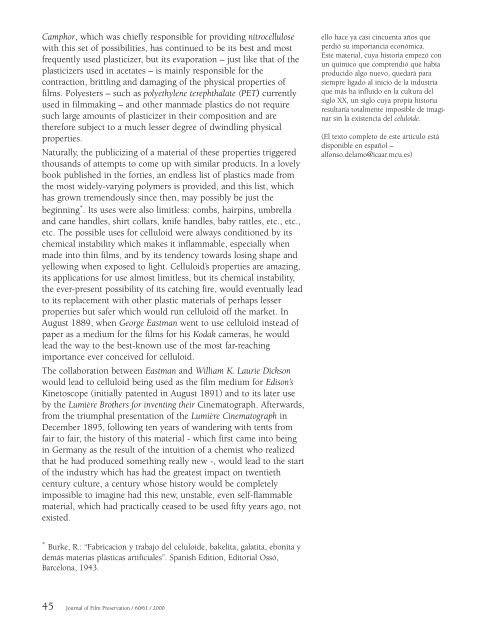Journal of Film Preservation N° 60/61 - FIAF
Journal of Film Preservation N° 60/61 - FIAF
Journal of Film Preservation N° 60/61 - FIAF
Create successful ePaper yourself
Turn your PDF publications into a flip-book with our unique Google optimized e-Paper software.
Camphor, which was chiefly responsible for providing nitrocellulose<br />
with this set <strong>of</strong> possibilities, has continued to be its best and most<br />
frequently used plasticizer, but its evaporation – just like that <strong>of</strong> the<br />
plasticizers used in acetates – is mainly responsible for the<br />
contraction, brittling and damaging <strong>of</strong> the physical properties <strong>of</strong><br />
films. Polyesters – such as polyethylene terephthalate (PET) currently<br />
used in filmmaking – and other manmade plastics do not require<br />
such large amounts <strong>of</strong> plasticizer in their composition and are<br />
therefore subject to a much lesser degree <strong>of</strong> dwindling physical<br />
properties.<br />
Naturally, the publicizing <strong>of</strong> a material <strong>of</strong> these properties triggered<br />
thousands <strong>of</strong> attempts to come up with similar products. In a lovely<br />
book published in the forties, an endless list <strong>of</strong> plastics made from<br />
the most widely-varying polymers is provided, and this list, which<br />
has grown tremendously since then, may possibly be just the<br />
beginning * . Its uses were also limitless: combs, hairpins, umbrella<br />
and cane handles, shirt collars, knife handles, baby rattles, etc., etc.,<br />
etc. The possible uses for celluloid were always conditioned by its<br />
chemical instability which makes it inflammable, especially when<br />
made into thin films, and by its tendency towards losing shape and<br />
yellowing when exposed to light. Celluloid’s properties are amazing,<br />
its applications for use almost limitless, but its chemical instability,<br />
the ever-present possibility <strong>of</strong> its catching fire, would eventually lead<br />
to its replacement with other plastic materials <strong>of</strong> perhaps lesser<br />
properties but safer which would run celluloid <strong>of</strong>f the market. In<br />
August 1889, when George Eastman went to use celluloid instead <strong>of</strong><br />
paper as a medium for the films for his Kodak cameras, he would<br />
lead the way to the best-known use <strong>of</strong> the most far-reaching<br />
importance ever conceived for celluloid.<br />
The collaboration between Eastman and William K. Laurie Dickson<br />
would lead to celluloid being used as the film medium for Edison’s<br />
Kinetoscope (initially patented in August 1891) and to its later use<br />
by the Lumière Brothers for inventing their Cinematograph. Afterwards,<br />
from the triumphal presentation <strong>of</strong> the Lumière Cinematograph in<br />
December 1895, following ten years <strong>of</strong> wandering with tents from<br />
fair to fair, the history <strong>of</strong> this material - which first came into being<br />
in Germany as the result <strong>of</strong> the intuition <strong>of</strong> a chemist who realized<br />
that he had produced something really new -, would lead to the start<br />
<strong>of</strong> the industry which has had the greatest impact on twentieth<br />
century culture, a century whose history would be completely<br />
impossible to imagine had this new, unstable, even self-flammable<br />
material, which had practically ceased to be used fifty years ago, not<br />
existed.<br />
* Burke, R.: “Fabricacion y trabajo del celuloide, bakelita, galatita, ebonita y<br />
demás materias plásticas artificiales”. Spanish Edition, Editorial Ossó,<br />
Barcelona, 1943.<br />
45 <strong>Journal</strong> <strong>of</strong> <strong>Film</strong> <strong>Preservation</strong> / <strong>60</strong>/<strong>61</strong> / 2000<br />
ello hace ya casi cincuenta años que<br />
perdió su importancia económica.<br />
Este material, cuya historia empezó con<br />
un químico que comprendió que había<br />
producido algo nuevo, quedará para<br />
siempre ligado al inicio de la industria<br />
que más ha influido en la cultura del<br />
siglo XX, un siglo cuya propia historia<br />
resultaría totalmente imposible de imaginar<br />
sin la existencia del celuloide.<br />
(El texto completo de este artículo está<br />
disponible en español –<br />
alfonso.delamo@icaar.mcu.es)
















